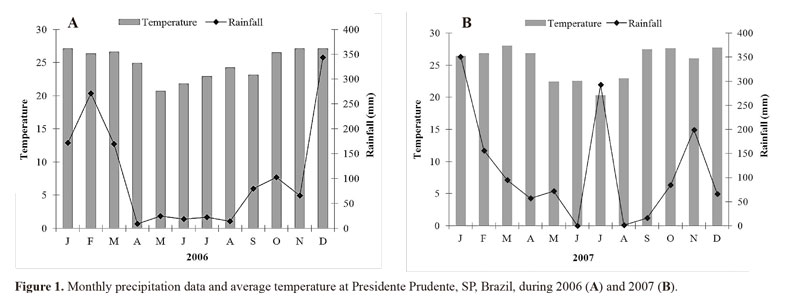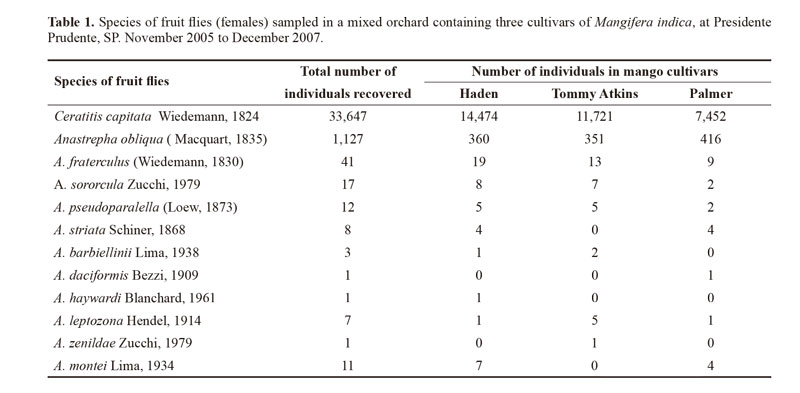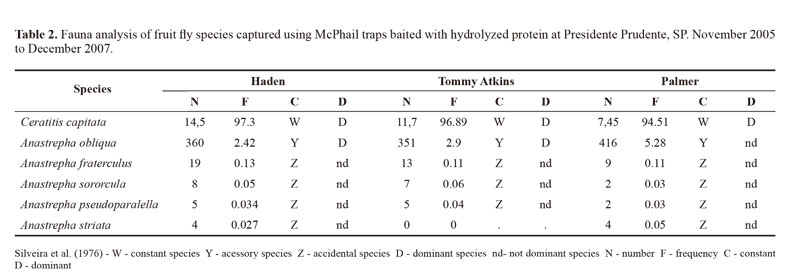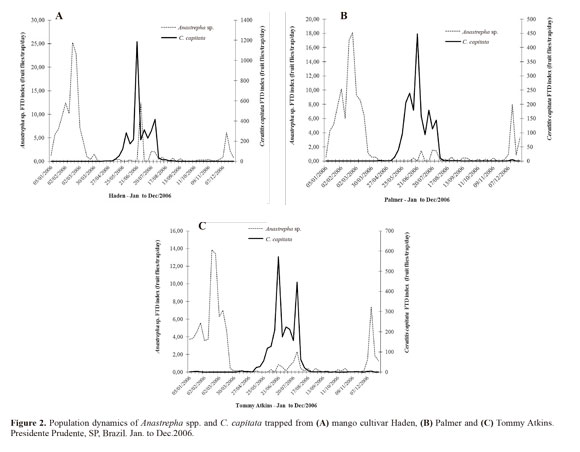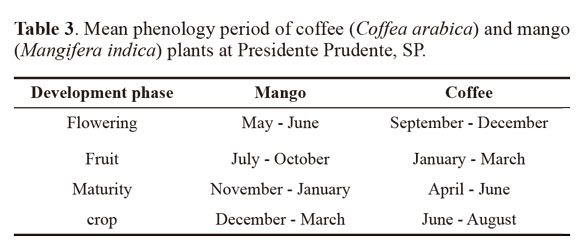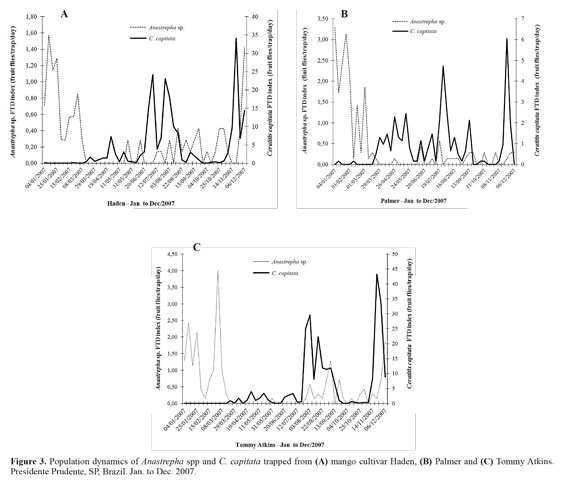Services on Demand
Journal
Article
Indicators
-
 Cited by SciELO
Cited by SciELO -
 Access statistics
Access statistics
Related links
-
 Cited by Google
Cited by Google -
 Similars in
SciELO
Similars in
SciELO -
 Similars in Google
Similars in Google
Share
Revista Colombiana de Entomología
Print version ISSN 0120-0488
Rev. Colomb. Entomol. vol.38 no.2 Bogotá July/Dec. 2012
Occurrence of fruit flies (Diptera: Tephritidae) in a mixed mango orchard in the city of Presidente Prudente, SP, Brazil
Presencia de moscas de la fruta (Diptera: Tephritidae) en un huerto mixto de mango en la ciudad de Presidente Prudente, SP, Brasil
SÔNIA MARIA NALESSO MARANGONI MONTES1, ADALTON RAGA2 and MIGUEL FRANCISCO DE SOUZA-FILHO2
1 Ph. D. Researcher - Regional Polo of Alta Sorocabana - APTA, Box 298, 19015-970 Presidente Prudente, São Paulo, Brazil, soniamontes@apta.sp.gov.br
2 Ph. D. Researcher - Laboratory of Economic Entomology, Biological Institute-APTA, Box 70, 13001-970, Campinas São Paulo, Brazil, adalton@biologicosp.gov.br; miguelf@biologico.sp.gov.br
Received: 10-Nov-2011 - Accepted: 22-Oct-2012
Abstract: The objective of this research was to determine the population dynamics and the diversity of fruit flies (Tephritidae) in a mixed orchard containing the mango (Mangifera indica) cultivars Haden, Tommy Atkins and Palmer, at the town of Presidente Prudente town, SP, Brazil. The population dynamics of fruit flies was measured from November 2005 to December 2007 through; weekly samplings of the adult insects, using yellow-bottomed McPhail traps baited with hydrolyzed protein. A total of 65,956 Tephritidae specimens was collected in nine traps, of which 2,788 were Anastrepha spp. (4.23%) and 63,168 Ceratitis capitata (95.77%). A total of 1,229 female specimens of Anastrepha was captured, of which 91.7% were A. obliqua, 3.3% A. fraterculus, 1.4% A. sororcula, 1.0% A. pseudoparalella and 0.7% A. striata. The remaining consisted of A. barbiellinii, A. daciformi, A. haywardi, A. zenildae, A. leptozona and A. montei. Ceratitis capitata and A. obliqua were the dominant species. In general, the highest densities of fruit flies occurred during the fruit-ripening period (from November to March), which is characterized by increased rainfall levels and high temperatures.
Key words: Anastrepha spp. Ceratitis capitata. Fauna analysis. Insecta. Mangifera indica.
Resumen: Esta investigación tuvo como objetivo determinar la dinámica de la población y la diversidad de las moscas de la fruta (Tephritidae) en un huerto mixto conteniendo los cultivares de mango (Mangifera indica) Haden, Tommy Atkins y Palmer, en la ciudad de Presidente Prudente, SP, Brasil. Se midió la dinámica poblacional de moscas de la fruta desde noviembre de 2005 hasta diciembre de 2007 a través de colectas semanales de adultos usando trampas McPhail de base amarilla con solución de proteína hidrolizada como cebo. Se colectó un total de 65.956 especímenes de Tephritidae en nueve trampas, de los cuales 2.788 fueron Anastrepha spp. (4,23%) y 63.168 Ceratitis capitata (95,77%). Se colectó un total de 1.229 de hembras de Anastrepha, de los cuales 91,7% fueron A. obliqua, 3,3% A. fraterculus, 1,4% A. sororcula, 1,0% A. pseudoparalella y 0,7% A. striata. El resto consistió de A. barbiellini, A. daciformis, A. haywardi, A. zenildae, A. leptozona y A. montei. Ceratitis capitata y A. obliqua fueron las especies dominantes. En general, las densidades más altas de moscas de la fruta ocurrió durante el período de maduración de las frutas (desde noviembre hasta marzo), el cual es caracterizado por niveles de precipitación incrementados y altas temperaturas.
Palabras clave: Anastrepha spp. Ceratitis capitata. Análisis de la fauna. Insecta. Mangifera indica.
Introduction
Mangoes (Mangifera indica L.) are native to South Asia and were only grown in Africa, the Americas and the Caribbean after the settlement of European explorations. Currently, mangoes are found worldwide in most tropical and subtropical areas (Donadio and Ferreira 2002; Waite 2002).
According to the Brazilian Agricultural Economics Institute (IEA), the state of São Paulo had a total of 2´349.963 mango trees in 2008, with a production of 81´92.243 boxes of 22 kg each. São Paulo’s production focuses primarily on the domestic market, particularly the large consumer centers in southeastern and southern Brazil, because it has the lower shipping cost as its main competitive advantage. The more recent orchards located in cities in the São Paulo, features varieties such as Tommy Atkins and Palmer, which have the potential to the export market.
High-quality fruits, free of pests, diseases and physiological disorders, are highly valuable commodities for exports. Fruit flies (Diptera: Tephritidae) are limiting factors for the international exports of mangoes (Cunha et al. 2000). The fruit fly larvae causes significant losses in fruit growing, as they feed on fresh fruits, making them improper for freshconsumption and industrialization (Orth et al. 1986).
A survey of the costs for implementing a fruit fly control program in Bahia indicated a total cost of 9.2% of the total mango production income, which included the costs of running the program in years of low infestation (Aguiar and Nascimento 2006).
Veloso (1997), based on trap collections from mango trees in Goiânia (GO), found A. obliqua (Macquart) and A. fraterculus (Wiedemann) in rural areas, and C. capitata in urban areas.
Several studies report the preference of A. obliqua for fruits of Anacardiaceae (Jirón et al. 1988; Jirón and Hedstrom 1991; Malavasi et al. 2000). Interspecies interaction studies done by Camargo et al. (1996) suggest that A. obliqua is a better competitor than C. capitata; this dominance may be attributed to the size of A. obliqua that are three times higher that C. capitata. Nascimento and Carvalho (2000) verified the predominance of A. obliqua in mango tree varieties regarded as "wild";, such as ‘Coité’, ‘Dedo-de-Dama’ and ‘Peito-de-Moça’.
In Brazil, a large number of fruit fly species (Zucchi 2000a) are reported, but only few species cause economic damages. The objective of the present study was to identify the fruit fly diversity and to determine the population dynamic of tephritids in a mixed mango orchard, located a town in the western region of São Paulo State in Brazil.
Material and Methods
The study was carried out from November 2005 to December 2007, in a mixed mango orchard, which included approximately 600 plants, distributed among varieties such as ‘Haden’, ‘Tommy Atkins’ and ‘Palmer’, located in the Espigão district, a municipality of Presidente Prudente in São Paulo State, Brazil (UTM 7545288.76m N, 459930.31m E, elevation 424,29 masl). The plants were more than 13 years old, and they were arranged in spacing of 9 x 4 m for cv. ‘Palmer’, 9 x 6 m for ‘Haden’, and 10 x 8 m for ‘Tommy Atkins’. The orchard had 35.960 m², corresponding to 120, 260 and 220 plants of ‘Palmer’, ‘Haden’ and ‘Tommy Atkins’, respectively. The rainfall and temperature data were obtained from the Meteorological Station of the Faculty of Science and Technology/UNESP, campus of Presidente Prudente, SP, approximately 11 km from the orchard (Figure 1).
To determine the fluctuation in the population of Tephritidae adults at the mango orchard, nine yellow-bottomed McPhail traps were set - four for the ‘Haden’ variety, three for ‘Tommy Atkins’, and two for ‘Palmer’. Hydrolyzed protein-based food baits were used, (Isca Tecnologias Brasil Ltda.®), diluted in water at 5% v/v. The traps were placed inside the canopy at 1.80 m in high and spaced 70 m from each other. A total of 400 mL of food bait was used per trap, refilled every seven days, at which time the contents of the trap were removed, transferred to 500 mL glass jars, and transported to the Plant Quality and Health Laboratory of the Alta Sorocabana Regional Center, SP. The Tephritidaespecimens were counted, sexed, fixed in 70% alcohol and kept in properly labeled flasks for later identification. The identification of Anastrepha was based on the keys developed by Steyskal (1977) and Zucchi (2000a).
A fauna analysis was performed during three years (2005, 2006 and 2007), using the occurrence and dominance indices of fruit flies, based on Silveira Neto et al. (1976). The population fluctuation results for Tephritidae adults between 2006 and 2007 were presented graphically as the number of captured flies/trap/day (FTD). The data for 2005 were not considered in the population fluctuation, as samplings lasted only one month, because of the low number of flies capture.
Results and Discussion
A total of 65,956 Tephritidae specimens was captured, comprising 63,168 specimens of C. capitata (95.77% of the total) and 2,788 specimens of Anastrepha spp. (4.23% of the total). C. capitata was represented by 46.74% of males and 56.26% of females; for Anastrepha spp., 55.92% were males and 44.08% females. The highest capture of fruit flies took place in 2006 (93.6%), with 96.21% of that total consisting of C. capitata and 3.78% of Anastrepha spp.
A total of 1,229 female specimens of Anastrepha and 33,647 specimens of C. capitata were captured during the study period, in mixed orchard mango. The total number of captured Anastrepha specimens in traps was divided among A. obliqua (91.7%), A. fraterculus (Wied.) (3.3%), A. sororcula Zucchi, 1979 (1.4%), A. pseudoparalella (Loew, 1873) (1.0%), A. striata Schiner, 1868 (0.7%), A. barbiellinii Lima, 1938 (0.2%), A. daciformis Bezzi ,1909 (0.08%), A. haywardi Blanchard 1961 (0.08%), A. zenildae Zucchi, 1979 (0.08%), A. leptozona Hendel, 1914 (0.6%) and A. montei Lima, 1934 (0.9%) (Table 1). The specimens obtained in this work were generally monomorphic, following the pattern featured in the description of the species, with the exception of A. obliqua, which showed variations in the aculeus apex. According to Araújo and Zucchi (2006), the measurements of the aculeus (total and apex) of Anastrepha species vary throughout its geographic distribution and also among the exemplars obtained from a single host.
The occurrence of A. haywardi represents the second record of this species in Brazil, which was found for the first time in Mato Grosso do Sul by Uchôa-Fernandes and Zucchi (2000). McPhail traps can attract different Anastrepha species, at different degrees of intensity (Aluja et al. 1989). Anastrepha pickeli, and A. montei are related to cassava crops in adjacent areas to the orchard (Montes et al. 2010). In the case of A. daciformis and A. haywardi captured in traps, both species have no known hosts (Zucchi 2000b; Souza-Filho et al. 2000). In Brazil, A. fraterculus, A. obliqua, A. pseudoparallela and A. turpiniae Stone 1942 have been reported in mango crop (Zucchi 2000b). Of the 12 Tephritidae species collected in our study, seven had already been reported by Raga et al. (1996), using McPhail traps installed in a citrus orchard located in Presidente Prudente: C. capitata, A. fraterculus, A. barbiellinii, A. sororcula, A. obliqua, A. leptozona and A. dissimilis Stone, 1942.
In Costa Rica, Jirón and Hedstrom (1991) using McPhail traps, with Torula yeast plus borax as attractant, collected 97.6% Anastrepha spp. Schinner, 2.0% C. capitata (Wied.) and 0.4% Toxotrypana curvicauda Gerstaecker. Anastrepha obliqua was the species most closely associated with mango. Garcia et al. (2003a, 2003b) observed that, in four municipalities of western Santa Catarina State, there was a dominance of A. fraterculus on orange, lemon, peach, tangerine and plum orchards, peaking in December and January. This period coincides with the beginning of fruit ripening and also with the occurrence of C. capitata in most orchards already studied in Brazil, except on orange fields in the municipality of São Carlos, SP.
It is likely that the high numbers of C. capitata captured in traps is due to the presence of coffee (Coffea arabica L.) plantations in the vicinity of the mango orchard - a phenomenon already reported by Mariconi and Iba (1955). According to Bateman (1972), fruit flies can show non-dispersive movements related to fruit availability, as flies need resources for feeding and oviposition. In the absence of food in the orchard, flies improve dispersive or migratory movements.
Considering the preference of C. capitata for coffee and peach as hosts (Raga et al. 2002; Souza-Filho et al. 2009), it is possible to infer that the dominance of C. capitata may have been caused by medfly migration following the coffee harvest season in Presidente Prudente, SP. In the same year, there were still coffee cherries in the second half of July until the first half of August. Although native to Africa, C. capitata has occurred with higher frequency in introduced fruit species in Brazil, even in tropical areas (Souza-Filho et al. 2000).
The Anastrepha species recorded in the present study occurred rarely, with the exception of A. obliqua, which received the status of a constant species (Table 2). Ceratitis capitata and A. obliqua were the dominant species for cultivars Haden and Tommy Atkins, whereas for cultivar Palmer it was an accessory, not dominant species. The remaining species of Anastrepha detected in this study were not dominant.
Lima et al. (2004), recorded 837 tephritids adults from Tommy Atkins mango orchard located in the Rio Grande do Norte State, with the dominance of C. capitata (76.34%) besides A. sororcula, A. fraterculus, A. obliqua, A. pickeli Lima 1934 and A. serpentina (Wied. 1830). The fly/trap/day (FTD) value was 0.05 for C. capitata and 0.02 for Anastrepha spp.
In the state of Goiás, Ferreira et al. (2003) reported A. obliqua (48.78%), A. fraterculus (47.97%), A. sororcula (2.03%), A. turpiniae Stone 1942 (1.22%) and Neosilba sp. (Lonchaeidae), with preference by Tommy Atkins and Imperial.In the Amazon region, Silva (1993) characterized four locations with regard to frequency and dominance of fruit flies collected in host fruits, and concluded that A. obliqua was predominant. In Minas Gerais, Canal et al. (1998) concluded that C. capitata was predominant in urban areas and A. obliqua plus A. zenildae in rural areas, whose dominance may show variations according to the region and host fruit availability. In the present study, we obtained predominance of C. capitata and A. obliqua on mango. Probably, the occurrences of the remainder Tephritidae species are due to migration for food and shelter.
Population dynamics of fruit flies. The population fluctuation of a C. capitata in the mango orchard occurred between May and August 2006, peaking in June-July (Figs. 2A-C). In the period from September 2006 to April 2007, the Mediterranean fruit fly was practically absent, and only one population peak took place in 2006. In 2007, a peak was also observed in July and in November (Figs. 3A-C) a likely incursion of C. capitata from other orchards. Considering that C. capitata shows a preference for coffee and peach (Raga et al. 2002; Souza-Filho et al. 2009), it is likely that Mediterranean fruit fly populations migrated to the experimental area after the coffee harvest. The coffee harvest normally occurs from May to June, sometimes extending until July (Table 3), which allows fruit flies to complement their life cycle, resulting in population migration in search of food and shelter (Raga et al. 2002). Montes et al. (2012) collected 36,932 individuals of C. capitata in McPhail traps installed in a coffee orchard, from 2005 to 2007, with population peaks in May, June and July.
The species of Anastrepha collected in McPhail traps occurred from December to March 2006, with the highest point in February-March for all three evaluated cultivars. In 2007, occurrence was observed between November 2006 and March 2007; in cv. Tommy Atkins. However, a second peak was observed in August/September (Figs. 2A-C and 3A-C). In 2006, fly infestation was greater than in 2007, with FTD indexes of 4.5 in cv. Haden, 1.38 in Tommy Atkins, and 9.07 in Palmer, compared to, 0.36, 1.33 and 1.64 for Haden, Tommy Atkins and Palmer, respectively. Cultivar Palmer showed a higher FTD index than Haden and Tommy Atkins, which may be attributed to the slower behavior of the cultivar compared to the others. This occurrence, caused flies migration to the trees bearing ripened fruits after the harvesting of more precocious cultivars. Another possibility is that volatile compounds produced by Palmer plants are more attractive to Tephritidae adults.The population peak of fruit flies in São Paulo State generally occurs between the months of September and December (Suplicy Filho et al. 1978, 1987; Raga et al. 1996). This is due particularly to the great supply of host fruits during that period, combined with favorable climatic conditions. Outside that time frame, the population peak of A. fraterculus is observed between March and April, in the season for precocious citrus varieties and guava (Souza-Filho and Raga 1998; Raga et al. 2004; Raga et al. 2006).
In general, Anastrepha species showed high densities during the period of abundance for ripe mango fruits –November to March– with intense rainfall and high temperatures (Fig. 1A and 1B, Table 3). The association of Anastrepha occurrence with the fruiting of mango was also observed by Jirón and Hedstrom (1991) and Soto-Manitu and Jirón (1989), in Costa Rica. Martínez and Godoy (1986) observed that meteorological factors exert little influence on the population fluctuation of A. obliqua, in mango orchards in Venezuela.
The results of this study may contribute to a better understanding of the fruit fly community in mango. These data will be of a great importance for the implementation of an integrated pest management program for fruit flies in the studied area.
Literature cited
AGUIAR, W.M.M.; NASCIMENTO, A.S.do. 2006. Análise dos custos do programa de controle das moscas-das-frutas na cultura da manga no pólo frutícola de Vale do Rio Brumado, BA. Cultura da mangueira, sistema de produção; socioeconomia. Brasília. Embrapa 9 (1): 84-93. [ Links ]
Aluja, M.; Cabrera, M.; Guillen, J.; Celedonio, H.; Ayora, F. 1989. Behaviour of Anastrepha ludens, A. obliqua and A. serpentina (Diptera: Tephritidae) on a wild mango tree (Mangifera indica) harbouring three McPhail traps. Insect Science and its Application 10 (3): 309-318. [ Links ]
Araújo E. L.; Zucchi, R. A. 2006. Medidas do acúleo na caracterização de cinco espécies de Anastrepha do Grupo fraterculus (Diptera: Tephritidae). Neotropical Entomology 35 (3): 29-337. [ Links ]
Bateman, M. A. 1972. The ecology of fruit flies. Annual Review of Entomology 17: 493-518. [ Links ]
Camargo, C. A.; Odell, E.; Jirón, L. F. 1996. Interspecific interactions and host preference of Anastrepha obliqua and Ceratitis capitata (Diptera: Tephritidae), two pests of mango in Central America. Florida Entomologist 79 (2): 266-268. [ Links ]
Canal, N. A.; Alvarenga, C. D.; Zucchi, R. A. 1998. Análise faunística de espécies de moscas-das-frutas (Dip., Tephritidae) em Minas Gerais. Scientia Agrícola 55 (1). [ Links ]
Cunha, M. M.; Santos Filho, H. P.; Nascimento, A. S. 2000. Manga. Fitossanidade, Embrapa, Brasília, DF. 104 p. [ Links ]
Donadio, L. C.; Ferreira, F. R. 2002. Mangueira. pp. 351-372. In: Bruckner, C. H. (Ed.). Melhoramento de fruteiras tropicais. UFV, Viçosa, Minas Gerais. 422 p. [ Links ]
Ferreira, H. de J.; Veloso, V. da R. S.; Naves, R. V.; Braga Filho, J. R. 2003. Infestação de moscas-das-frutas em variedades de manga (Mangifera indica L.) no Estado de Goiás. Pesquisa Agropecuária Tropical 33 (1): 43-48. [ Links ]
Garcia, F. R. M.; Campos, J. V.; Corseuil, E. 2003a. Análise faunística de sp moscas-das-frutas (Diptera: Tephritidae) na região Oeste de Santa Catarina. Neotropical Entomology 32 (3): 421-426. [ Links ]
Garcia, F. R. M.; Campos, J. V.; Corseuil, E. 2003b. Flutuação populacional de Anastrepha fraterculus (Wiedemann, 1830) (Diptera: Tephritidae) na região oeste de Santa Catarina, Brasil. Revista Brasileira de Entomologia 47 (3): 180-185. [ Links ]
Jirón, L. F.; M. Soto-Manitu, M.; Norrbom, A. L. 1988. A preliminary list of the fruit flies of the genus Anastrepha (Diptera: Tephitidae) in Costa Rica. Florida Entomologist 71 (2): 130-137. [ Links ]
Jirón, L. F.; Hedstrom, I. 1991. Population fluctuations of economic species of Anastrepha (Diptera: Tephritidae) related to mango fruiting phenology in Costa Rica. Florida Entomologist 74 (1): 62-73. [ Links ]
Lima, T. C. da C.; Silva, T. G. A. da; Costa, G. M. de M.; Souza, J. M. N. G. de; Medeiros, M. A. de A.; Gomes, C. S.; Moura, T. K. de M. P.; Oliveira, T. F.; Silva, D. N.; Macedo, F. P. 2004. Ocorrência de moscas-das-frutas (Diptera: Tephritidae) em pomar comercial de Mangifera indica cultivar Tommy Atkins na região litorânea de RN. In: XX Congresso Brasileiro de Entomologia, 5-10 setembro 2004, GRAMADO, RS, Brasil. [ Links ]
Malavasi, A.; Zucchi, R. A.; Sugayama, R. L. 2000. Biogeografia. pp. 93-98. In: Malavasi, A.; Zucchi, R. A. (Eds.). Moscas-das-frutas de importância econômica no Brasil: conhecimento básico e aplicado. Ribeirão Preto: Holos. 327 p. [ Links ]
Mariconi, F. A. M.; S. A. Iba. 1955. A mosca do mediterrâneo. O Biológico 21 (2): 17-31. [ Links ]
MartÍnez, N. B.; GODOY, F. J. 1986. Influencia de los factores meteorológicos sobre la fluctuación poblacional de Anastrepha obliqua Mcquart (Diptera: Tephritidae) en mango. Agronomia Tropical 36 (1-2): 55-65. [ Links ]
MONTES, S. M. N. M.; RAGA, A.; SOUZA-FILHO, M. F. de. 2010. Dynamic population of fruit flies in Cassava crops (Manihot esculenta). In: 8th International Symposium on Fruit Flies of Economic Importance, 26 Sept to 1 Oct, Valencia, Spain. [ Links ]
MONTES, S. M. N. M. 2012. Moscas-das-frutas em cultivares de cafeeiros de Presidente Prudente, SP. Coffee Science 7 (2): 120-127. [ Links ]
Nascimento, A. S.; CARVALHO, R. S. 2000. Manejo Integrado de Moscas-das-frutas. pp. 169-173. In: Malavasi, A.; Zucchi, R. A. (Eds.). Moscas-das-frutas de importância econômica no Brasil: conhecimento básico e aplicado Ribeirão Preto: Holos. 327 p. [ Links ]
Orth, A.; RIBEIRO, L. G.; REIS FILHO, W. 1986. Manejo de pragas. pp. 341-379. In: EMPRESA CATARINENESE DE PESQUISA AGROPECUARIA. Manual da cultura da macieira. Florianópolis. 743 p. [ Links ]
RAGA, A.; SOUZA-FILHO, M. F.; SATO, M. E.; CERÁVOLO, L. C. 1996. Dinâmica populacional de adultos de moscas-das-frutas (Diptera: Tephritidae) em pomar de citros de Presidente Prudente, SP. Arquivos do Instituto Biológico 63 (2): 23-28. [ Links ]
RAGA, A.; PRESTES, D. A. O.; SOUZA FILHO, M. F.; SATO, M. E.; SILOTO, R. C. ; ZUCCHI. R. A. 2002. Occurrence of fruit flies in coffee varieties in the State of São Paulo, Brazil. Boletín Sanidad Vegetal y Plagas 28: 519-524. [ Links ]
Raga, A.; Prestes, D. A. O.; Souza Filho, M. F.; Sato, M. E.; Siloto, R. C.; Guimarães, J. A.; Zucchi, R. A. 2004. Fruit fly (Diptera: Tephritoidea) infestation in citrus in the state of São Paulo, Brazil. Neotropical Entomology 33 (1): 85-89. [ Links ]
Raga, A.; Souza-Filho, M. F.; Prestes, D. A. O.; Azevedo Filho, J. A.; Sato, M. E. 2006. Susceptibility of guava genotypes to natural infestation by Anastrepha spp. (Diptera: Tephritidae) in the municipality of Monte Alegre do Sul, State of São Paulo, Brazil. Neotropical Entomology 35 (1): 121-125. [ Links ]
Silveira Neto, S.; NAKANO, O.; BARBIN, D.; VILLA NOVA, N. A. 1976. Manual ecologia dos insetos. Piracicaba: Ed. Agronômica Ceres, 419 p. [ Links ]
Soto-Manitu, J. ; Jirón, l. f. 1989. Studies on the population dynamics of the fruits flies, Anastrepha (Diptera: Tephritidae) associated with mango (Mangifera indica L.) in Costa Rica. Tropical Pest Management 35 (4): 425-427. [ Links ]
Souza-Filho, M. F.; Raga, a. 1998. Moscas-das-frutas. Mudanças nas condições climáticas favorecem o aumento desses insetos. Citricultura Atual 1 (4): 12. [ Links ]
Souza-Filho, M. F.; Raga, a.; Zucchi, r. a. 2000. Moscas-das-frutas nos estados brasileiros: São Paulo. pp. 277-283. In: Malavasi, A.; Zucchi, R.A. (Eds.). Moscas-das-frutas de importância econômica no Brasil: conhecimento básico e aplicado. Ribeirão Preto: Holos, 327 p. [ Links ]
Souza-Filho, M. F.; Raga, a.; Azevedo-Filho, j. a.; Strikis, p. c.; Guimarães, j. a.; Zucchi, r. a. 2009. Diversity and seasonality of fruit flies (Diptera: Tephritidae and Lonchaeidae) and their parasitoids (Hymenoptera: Braconidae and Figitidae) in orchards of guava, loquat and peach. Brazilian Journal of Biology 69 (1): 31-40. [ Links ]
Steyskal, G. C. 1977. Pictorial key to species of the genus Anastrepha (Diptera: Tephritidae). The Entomological Society of Washington. 35 p. [ Links ]
Suplicy Filho, N.; Sampaio, a. s.; Myazaki, i. 1978. Flutuação populacional das "moscas-das-frutas"; (Anastrepha spp. e Ceratitis capitata (Wied, 1824) em citros na Fazenda Guanabara, Barretos, SP. O Biológico 44 (11): 279-284. [ Links ]
Suplicy Filho, N.; liveira, d. a.; Bitran, e. a.; Teófilo Sobrinho, j. 1987. Contribuição ao conhecimento da flutuação populacional de "moscas-das-frutas"; em citros. Arquivos do Instituto Biológico 54 (1/4): 63-70. [ Links ]
UCHÔA-FERNANDES, M. A.; ZUCCHI, R. A. 2000. Moscas-das-frutas nos estados brasileiros. pp. 241-245. In: Malavasi, A.; Zucchi, R. A. (Eds.). Moscas-das-frutas de importância econômica no Brasil:conhecimento básico e aplicado. Ribeirão Preto: Holos. 327 p. [ Links ]
VELOX V. R. S. 1977. Dinâmica populacional de Anastrepha spp. e Ceratitis capitata (Wied., 1824) (Diptera: Tephritidae) nos cerrados de Goiás. Tese de doutorado. Escola de Agronomia da Universidade Federal de Goiás. Goiânia, Goiás. 115 p . [ Links ]
WAITE, G. K. 2002. Pests and pollinators of mango. pp.103-129. In: Peña, J. E.; Sharp, J. L.; Wisoki, M. (Eds.). Tropical fruit pest and pollinators. New York: CAB International. [ Links ]
ZUCCHI, R. A. 2000a. Taxonomia. pp. 13-24. In: Malavasi, A.; Zucchi, R. A. (Eds.). Moscas-das-frutas de importância econômica no Brasil:conhecimento básico e aplicado. Ribeirão Preto: Holos. 327 p. [ Links ]
ZUCCHI, R. A. 2000b. Espécies de Anastrepha, sinonímias, plantas hospedeiras e parasitóides. pp. 41-48. In: Malavasi, A.; Zucchi, R. A. (Eds.). Moscas-das-frutas de importância econômica no Brasil:conhecimento básico e aplicado. Ribeirão Preto: Holos. 327 p. [ Links ]













